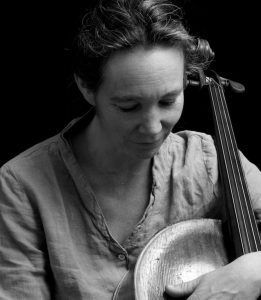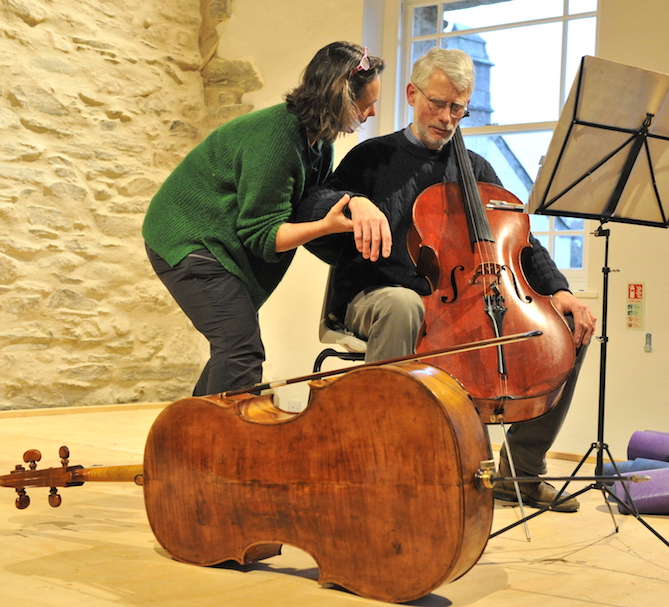Non-Doing
The tennis player observes the ball as it leaves his racket and completes the trajectory he has sent it on. He is no longer ‘in control’ of the ball but rather relaxed, alert and watchful. Primed for the return. Once we have learned to initiate movement from our core, we must then practice not interfering in it. For those of us who have learned that playing is all about control, holding and doing, this is quite a challenge, and yet this is what allows us to replace fear of being out of control with freedom and ease.
Gravity
“When the abandonment to gravity comes into action, resistance ceases, fear vanishes, order is regained, nature starts again to function in its natural rhythm and the body is able to blossom fully, allowing the river of life to flow freely through all parts.” – Awakening the spine…Vanda Scaravelli
It takes strength to hold a bow-arm from the string, and with added adrenalin this becomes even more challenging. Fearful of dropping it or crashing onto the string we grip the bow harder and migrate to the tip to escape the arm-weight we cannot control. That’s a lot of doing for a small sound! Practicing in a way that works with, rather than against gravity, we reorganize rather than withhold the weight. In forte, for example, the arm is aligned so that there are as few kinks as possible and the weight flows freely into the string. In pianissimo the elbow is low and the weight, unable to travel up the hill of the forearm just as water does not travel up a U-bend, rests at the elbow. All dynamic nuances (plus their corresponding vibrato width in the left hand) arise from the natural play between these two attitudes of tension and release, best illustrated in the action of bouncing a ball.
The Still Point
“…Except for the point, there would be no dance, and there is only the dance.” – TS Eliot
At the end of the out-breath there is a still point. A point of non-doing, of rest and relaxation. It is also a point of regeneration. T.S Eliot calls it ‘the still point of the turning world’. There is such a point in the arc of the bow, in each note, gesture and phrase. When a gesture is complete, and a note comes to a natural end (with the elbow down and wrist up in complete release) we have arrived there. For many it is a scary place, one we either flee on a regular basis or do not even know exists, but it is one I highly recommend making friends with and hanging out in! Complete relaxation of body and mind come, of course, only at the end of a piece of music, but there are degrees, and becoming familiar and comfortable with this still point means we can sail close to it whenever we need, continually regenerating ourselves and the musical line.
Practicing Non-Doing
To change our relationship to doing we need to learn to trust in the wisdom of our body more than the wisdom of our mind. This takes practice. Rather than trying to make the length of a note fit our idea, we practice allowing our note to be just as it is, in direct proportion to and a consequence of the preparation we make. We develop a kind of honesty by not interfering with it, and if we want it to be different, we go back to the preparation. (That is when we draw in the wisdom of our mind). If we work, first with one, then a series of notes, then an entire phrase in this way, eventually we are able to ‘generate’ a whole movement. Unencumbered by detail, we are driven rhythmically and harmonically, rather than by individual notes, entering into relationship with rather than controlling the music.
The next Breathing Bow retreat will be held in Provence with Ruth Phillips and Jane Fenton. 16-20 October 2018.
_________________________________________________________________
 Ruth Phillips was Born in London in 1964 and studied at the Yehudi Menuhin School with William Pleeth, and in Dusseldorf with Johannes Goritzki. In 1990, Ruth left a successful career with the Chamber Orchestra of Europe to continue her studies with Timothy Eddy at the State University of New York where she received her Masters’ degree in performance.
Ruth Phillips was Born in London in 1964 and studied at the Yehudi Menuhin School with William Pleeth, and in Dusseldorf with Johannes Goritzki. In 1990, Ruth left a successful career with the Chamber Orchestra of Europe to continue her studies with Timothy Eddy at the State University of New York where she received her Masters’ degree in performance.
Described as a ‘consummate coach’, Ruth draws on her training as a Voice Movement Therapist, and on many years’ work with yoga, mindfulness, meditation and Non-Violent Communication. Her generous spirit and organic approach to playing has helped people all over the world suffering from tension and stage fright find presence, ease and inspiration. Ruth runs individual Breathing Bow retreats from her home in Provence and has run workshops at the European String Teacher’s Association conference, the Royal Northern College of Music and the Royal Scottish Academy of Music. With her colleagues, Alexander teacher and cellist Dale Culliford, and yoga teacher and cellist Jane Fenton, Ruth runs group Breathing Bow retreats throughout Europe.
Ruth has an active life as a solo, orchestral and chamber musician on both baroque and modern cellos. Passionate about all types of music, she enjoys regular collaborations with folk singers, The Brothers Gillespie, and the Indian cellist Saskia Rao. She is co-principal cellist of Opera Fuoco in Paris. Ruth’s writing on breath and performance has appeared in many publications including The Strad and BBC music magazines, and her book, ‘Cherries from Chauvet’s Orchard’ was shortlisted for the Guardian women’s memoir award. She was involved in John Beder’s 2016 documentary on stage fright, ‘Composed’, and her playing of Bach is featured on the soundtrack.
http://thebreathingbow.com








